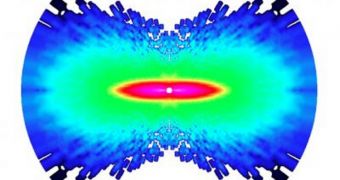A team of investigators from the Ohio State University announces that it managed to capture images of two atoms vibrating within a molecule. This is the first time direct observations of this phenomena were conducted.
The experiment was made possible through the use of a new, ultra-fast camera, able to produce real-time images of this elusive phenomenon. Details of the research effort were published in the latest issue of the top scientific journal Nature.
In order for the atomic motions to become visible, the investigators decided to use the energy of electrons inside the molecules as a light source. They then shone extremely brief laser pulses over the molecule, in such a way that they knocked off one of the electrons, taking it out of its standard orbit.
The elementary particle than returned to its original position in a scattered patterns, similar to the one produced by water ripples in a pond. According to the research group, this achievement could finally open the way towards a complete understanding of what happens during chemical reactions.
Once that objective is reached, it may become possible to control these reactions at an atomic scale, researchers explain. Louis DiMauro, an OSU expert, was the principal investigator on this study.
“Through these experiments, we realized that we can control the quantum trajectory of the electron when it comes back to the molecule, by adjusting the laser that launches it. The next step will be to see if we can steer the electron in just the right way to actually control a chemical reaction,” he says.
The imaging technique the team used is called laser induced electron diffraction (LIED), and it is especially well suited for analyzing molecules such as nitrogen and oxygen (N2 and O2). These common atmospheric gases are already understood in detail.
A molecule comprising one oxygen atom and one nitrogen atom was then bombarded with 50-femtosecond-long infrared laser pulses. A femtosecond is one millionth of one billionth of a second, EurekAlert reports.
DiMauro and Cosmin Blaga, a postdoctoral researcher at OSU, say that the scattered electron signal is very similar to the one photons create when they pass through slits. The motion of atoms was established by borrowing some concepts from optics.
The diffraction pattern of the knocked-off electron was used to reconstruct the position of atomic nuclei inside the molecule at the time of the laser blast. Through this approach, experts were able to construct a series of animations showing the intra-molecular atomic vibrations.
“You could use this to study individual atoms, but the greater impact to science will come when we can study reactions between more complex molecules. Looking at two atoms – that's a long way from studying a more interesting molecule like a protein,” DiMauro concludes.

 14 DAY TRIAL //
14 DAY TRIAL //